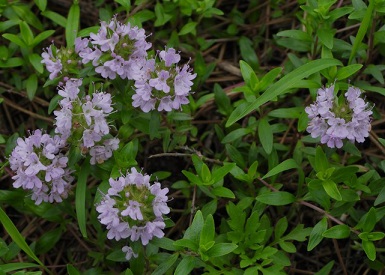Korean Murine Study Shows That Thymus Quinquecostatus Celakovski Can Possibly Enhance Testosterone Levels In Aging Men!
Nikhil Prasad Fact checked by:Thailand Medical News Team May 05, 2024 11 months, 1 week, 2 days, 8 hours, 38 minutes ago
Anti-Aging: Late-onset hypogonadism (LOH) is a condition primarily seen in aging men, characterized by reduced testosterone levels leading to various symptoms like decreased libido, erectile dysfunction, and mood disturbances. The search for effective treatments has led researchers to explore herbal remedies, and a recent South Korean study delves into the potential of Thymus quinquecostatus Celakovski (TQC) in addressing LOH. This
Anti-Aging new report takes an in-depth look at the study's findings, the role of cytochrome P450 (CYP) enzymes in testosterone synthesis, and the implications of herbal medicine in LOH management.
 Thymus Quinquecostatus Celakovski Can Possibly Enhance
Thymus Quinquecostatus Celakovski Can Possibly Enhance
Testosterone Levels In Aging Men
Understanding Late-Onset Hypogonadism
LOH is a complex syndrome associated with aging, marked by declining testosterone levels that impact overall health and well-being in men. The interplay between gonadotropin-releasing hormone (GNRH) secretion, luteinizing hormone (LH) levels, and Leydig cell activity underscores the physiological changes contributing to LOH. Testosterone, a key hormone in male development and function, undergoes synthesis processes involving cytochrome P450 (CYP) enzymes, notably Cyp11a1, Cyp17a1, and Cyp19a1, which are crucial for testosterone biosynthesis and androgen metabolism.
Current Treatment Landscape and Herbal Medicine
Current treatments for LOH, such as testosterone replacement therapy, come with risks and considerations, including potential side effects like prostate issues and infertility. This has prompted a shift towards exploring alternative therapies like herbal medicine, known for their relatively lower adverse effects. However, the efficacy and safety profiles of herbal remedies like ginseng extract, decursin, and quercetin in LOH management require further investigation.
Exploring Thymus Quinquecostatus Celakovski
Thymus quinquecostatus Celakovski (TQC) emerges as a potential candidate due to its traditional use and pharmacological properties, including anti-inflammatory and analgesic effects. The study in question aimed to assess the effects of TQC extract (TE) on LOH using both in vitro and in vivo models.
In Vitro Studies: TM3 Leydig Cells
The study initially focused on TM3 Leydig cells, crucial in testosterone synthesis. TE treatment resulted in a significant dose-dependent increase in testosterone levels without compromising cell viability. Gene expression analysis revealed upregulation of Cyp11a1, Cyp17a1, Cyp19a1, and Srd5a2, key players in testosterone biosynthesis and metabolism, further validating TE's potential in enhancing testosterone production.
In Vivo Studies: Aging Mouse Models
Transitioning to in vivo models, TE administration showcased promising results. It increased testosterone levels without affecting body weight or organ weights, indicating its safety profile. Moreover, TE-treated groups exhibited improved
gene expression related to testosterone synthesis compared to controls, emphasizing TE's regulatory role in testosterone pathways.
Identification of Bioactive Compounds
High-performance liquid chromatography-mass spectrometry (HPLC-MS) analysis identified caffeic acid (CA) and rosmarinic acid (RA) as bioactive compounds in TE. These compounds, known for their testosterone-boosting effects in previous studies, were further investigated for their individual and synergistic impacts on testosterone levels in TM3 cells.
Synergistic Effects of CA and RA
While individual treatments with CA or RA showed modest effects on testosterone levels, their synergistic combination at specific concentrations significantly increased testosterone production. This synergistic action aligns with the observed upregulation of genes associated with testosterone synthesis, reinforcing the role of CA and RA as active ingredients in TE.
Implications and Future Directions
The findings from this study shed light on the therapeutic potential of TQC and its bioactive compounds in managing LOH. By targeting CYP enzymes and modulating testosterone pathways, TE shows promise as a natural alternative to conventional treatments. Further research into dosage optimization, long-term effects, and clinical trials will be crucial in establishing TE as a viable therapeutic option for aging men with LOH.
.jpg)
S
chematic model of Thymus Quinquecostatus effect on testosterone
production in Late-onset hypogonadism animal model
Conclusion
In conclusion, the South Korean study underscores the significance of TQC extract in enhancing testosterone levels through its regulation of key genes and pathways involved in testosterone synthesis and metabolism. The discovery of CA and RA as bioactive compounds further enriches our understanding of TE's mechanisms of action. With ongoing advancements in herbal medicine research, TE stands as a promising avenue for addressing the challenges posed by late-onset hypogonadism in aging men, paving the way for safer and more effective treatment options.
The findings of the study conducted by researchers from Korea Institute of Oriental Medicine, Food & Supplement Health Claims, Vitech, Jeonbuk National University and the University of Science & Technology, Daejeon-South Korea were published in the peer reviewed journal: Biomedicine & Pharmacotherapy.
https://www.sciencedirect.com/science/article/pii/S0753332224005845
For the latest on
Anti-Aging, please keep on logging to Thailand Medical News.

.jpg)